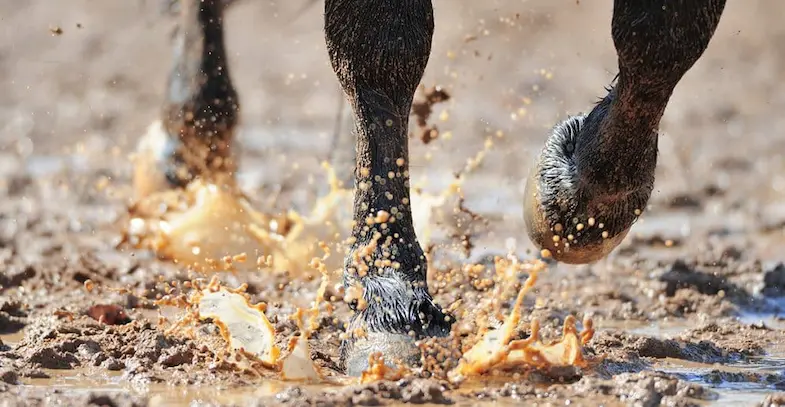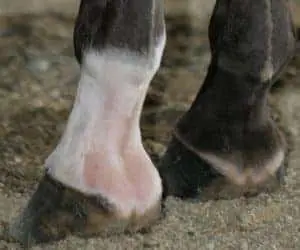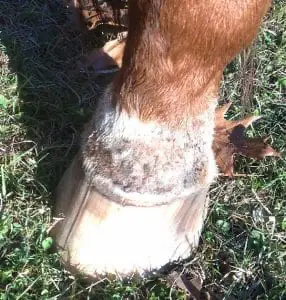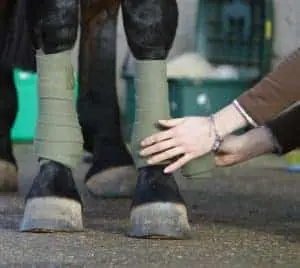Contrary to its name, mud fever doesn’t only affect horses that are turned out in muddy fields, it has many different names such as dew poisoning, greasy heel, and of course mud fever. Any horse can suffer from it at any time of year but thankfully in the vast majority of cases, it’s not serious and will only cause irritation. The good news though is that it’s not only relatively straightforward to treat but it can also easily be prevented.
What is mud fever?
Also known as pastern dermatitis, mud fever isn’t actually one condition but is instead a collective name for a range of different diseases that are all caused by irritation, bacteria, or fungal infection and affect a horse’s lower legs. One of the most common causes of mud fever is a bacteria called Dermatophilus congolensis that lives naturally on the skin but is also thought to live in mud. The bacteria aren’t able to break through the surface of the skin normally but find it easier to do so when the skin has been weakened in some way.
Mud fever is more prevalent during the wet winter months when the ground is often very wet and muddy, conditions that work to weaken the skin of the horse’s lower legs which makes it much easier for the bacteria to get in.
While it is far more common during the winter a horse can suffer at any time of year, for example, dew poisoning which occurs when a horse grazes through wet clover (normally during the summer) can lead to the same weakening of the skin that helps to promote the growth of the bacteria. Photosensitivity and chronic mange mites can also help to exacerbate the problem.
Is mud fever contagious?
There’s no definitive answer to this as some people will say it is contagious while others will say it’s not. It’s certainly not classed as a contagious disease but because it’s commonly caused by a bacteria that lives naturally on the skin it’s unlikely there’ll be just one case at a yard.
Some horses seem to have an immunity to the bacteria and just won’t suffer from mud fever but in my opinion its always better to err on the side of caution. Not sharing boots, bandages, or wraps with other horses will help to stop the spread of the bacteria.
Another way to stop the bacteria spreading, either to other horses or a different leg on your horse, is to either use a separate towel for each leg or use disposable kitchen towels for each leg. If you do use disposable towels though make sure you don’t use the cheapest ones, these will often break apart and aren’t so absorbent. The best option is to use the mid-priced towels, these tend to be very absorbent and won’t fall apart but don’t cost too much either.
Can you ride a horse with mud fever?
In most cases, you can continue to ride if your horse is suffering from mud fever but you should keep to dry ground. If you’re worried that your horse may get his lower legs wet then either don’t ride him or use waterproof wraps or boots. It’s also important to keep to light work, you don’t want to do anything that could either open up soar skin or cause your horse to sweat too much.
How do you treat mud fever in horses?
While the mud fever itself is, in most cases, easy to treat it’s also important to deal with the cause of the condition too, if possible. This will help to reduce the amount of time your horse is suffering for but will also reduce the chances of reinfection at a later date.
It’s important to let the air get to the infected area(s) so you don’t want to dress your horse’s legs unless you really have to. It may also be a good idea to clip or trim the hair around the infection to allow the air to get to it better, doing this will also help to make sure any topical cream is applied exactly where it’s needed.
The first thing you need to deal with is the infection which should be done by keeping the area clean and by regularly applying topical antiseptic cream (something like Sudocrem® is perfect, or coconut oil if you’d prefer a natural alternative). It’s important to keep your horse’s legs dry until the infection has gone and his wounds have healed, if you can stable him at night, or make sure his pasture is dry, even if you have to fence a smaller area off for him.
It should only take a few days or a week for the infection to go but if it hasn’t within this time then you should speak to your veterinarian for advice, he may decide your horse needs a strong prescription cream.
How do you remove mud fever scabs?
Once your horse is free from infection you can start to remove the scabs but you need to be gentle when doing so and also make sure that everything is clean, otherwise, you run the risk of reinfection.
Apply a little bit of warm water to the scabs, this will help to soften them and make it easier to peel the scabs off. If they won’t come off easily don’t force them, try applying water for a little bit longer. If they’re really thick then it can be painful for your horse if you try to remove them yourself, instead, speak to your veterinarian as he may have to remove the scabs under sedation.
Once you’ve removed them clean the wounds and surrounding areas with warm diluted horse safe disinfectant (such as Hibiscrub), this will help to clean the area but also keep any bacteria on the surface. After you’ve done this you need to thoroughly dry your horse’s legs, you can do this by either using a towel (or disposable kitchen towels) or, if your horse doesn’t mind the noise, a hairdryer on low heat. When the legs are completely dry you should also use a barrier cream on the area to not only help prevent further infection but also to aid the healing process.
What’s the best natural remedy for mud fever?
They are many natural treatments that can work to both prevent and treat mud fever. One of the most popular remedies is coconut oil, it has anti-microbial, anti-viral, and anti-fungal properties that can help to soothe the area as well as prevent fungus and bacteria from growing which will help to not only treat mud fever but will also prevent it from occurring again in the future.
When it comes to preventing mud fever it’s important to make sure your horse’s skin and coat are in good condition, while most horses will get enough vitamins and minerals from their diet if your horse has a deficiency then you may want to a supplement. Supplements containing omega 3 will help to improve the condition of his coat, while those with fatty acids and vitamins E and B12 will help to improve both the skin and coat.
How do you prevent mud fever in horses?
There will always be some horses that have an underlying health condition that makes them more prone to mud fever, but in most cases, it can be prevented. Regardless of whether your horse is stabled or turned out you still need to keep his legs as dry as possible so that the skin doesn’t become weaken and therefore more likely to let the bacteria in.
If he’s stabled then the stall should, of course, be clean and dry but it should also be well ventilated. This will help to keep the air flowing which makes it harder for the bacteria to grow. You should also remove use bedding every day so that your horse isn’t standing it urine-soaked bedding.
It can be harder to keep the legs of horses that are turned out dry but with careful pasture management, it is possible. If you have more than one field then rotate which field he’s turned out in, this will help to keep the ground more solid but will also have the added benefit of helping to control worms. Fencing off boggy or excessively muddy areas will also help to reduce the risk, as will using some sort of barrier cream on your horse’s legs when you turn him out. The cream will stop the mud from damaging your horse’s legs but will also prevent any bacteria from getting in.
When it comes to exercise using bandages or wraps can help to keep the legs dry, some bandages are even waterproof but just make sure you remove them afterward otherwise they could make your horse’s legs sweat and therefore exacerbate the problem.
If your horse’s legs do get muddy though DON’T wash the mud off, this is likely to increase the chances of the skin being damaged. Instead, wait until the mud has dried then use a soft brush to remove it before applying a topical barrier cream.
Probably the most important thing in preventing mud fever though is checking your horse every day. That might sound like an obvious thing to say but if you check his heels and lowers legs for any early signs you can treat those immediately before they develop into anything else. Make sure you wash any small cuts and grazes straightaway.
Can you use supplements to prevent mud fever?
Most horses are able to get enough of the vitamins and minerals they need from their diet but if your horse isn’t able to do so you might want to think about a supplement that can help to maintain healthy skin, this will help your horse better resist and recover from the damage that is often caused by wet weather conditions.
If you do use a supplement then its important to look for one that contains some of the following ingredients:
- Zinc – This will help to form keratin and collagen, both of which are crucial for maintaining healthy skin.
- Biotin (or vitamin B7) – Like zinc, it’s used to create keratin.
- Vitamin C – We all know that vitamin C is good at keeping colds at bay but the reason for this is because it can help to sustain a healthy immune system. This, in turn, will help a horse’s natural defenses to fight the bacteria.
- Vitamin E – This works in much the same way as vitamin C and when combined together they’re a powerful combination.
- Brewers Yeast – This is naturally high in many B vitamins and great for boosting your horse’s skin condition.
- Omega-3 – Ingredients such as linseed and flaxseed are both high in omega-3 which help to promote a healthy (and shiny) coat but also to improve the health of the skin.
Further reading
- Caring for an old horse
- Do horses need supplements
- Horse euthanasia explained
- The wonders of coconut oil
- Dealing with arthritis in horses
- Treating ulcers naturally
- Protecting your horse from sunburn
- Strangles – everything you need to know
- Why is my horse eating mud?
- What you should feed your horse
I hope you found this article helpful. If you did I’d be grateful if you could share it please as it would really help me.
Recommended products
Over the years I have tried hundreds of different horsey products, from various blankets and halters to different treats. Some I’ve loved, others I’ve hated but I thought I’d share with you my top all-time favorite products, the ones I never leave the yard without. I’ve included links to the products (which are in no particular order) that I really think are great.
- Horse Knots by Reference Ready – If you’re like me and enjoy pocket reference guides then you’ll love this knot tying guide. These handy cards can easily fit in your pocket or attach to the saddle for quick reference. They’re waterproof, durable and are color coded to make them easy to follow.
- Mane ’n Tail Detangler – Even if you never show your horse you’ll need to detangle his tail from time to time (and possibly his mane too) which is always a challenging chore! I’ve found that if I run a little bit of detangler through my horse’s tails every few days it stops them from getting matted up and makes combing them easy, even if they’re coated in mud. I don’t know if I should admit to this or not but it also works wonders on my hair.
- TAKEKIT Pro clippers – Over the years I’ve tried a lot of different clippers and while some were obviously better than others I found these to be by far the best. They are heavier than a lot of other clippers but for me, that’s a good thing, it makes them feel more sturdy and hardwearing. On top of that they have a range of speeds so are just as good for clipping your horse’s back as they are his face. I also like the fact that they come in a handy carry case but that’s not for everybody. The company that makes them is super good and incredibly helpful too, a real bonus these days. The only thing I wasn’t keen on was the fact that it doesn’t come with any oil, but that’s not a major problem as it’s not difficult to buy lubricant.
- Shire’s ball feeder – There are so many boredom buster toys out there but I like to use these every day, regardless of whether or not my horses are bored. I find that it helps to encourage my horses to problem solve by rewarding them with treats (or pieces of fruit) but it also mimics their natural grazing behavior which helps to keep them calm and de-stressed.
- Horse safe mirror – This is a strange one that many people are surprised about but I like to put horse safe mirrors in the trailers as well as in the quarantine stalls. It helps to prevent the feeling of isolation by giving the impression of other horses being around. Being herd animals horses can get extremely stressed when they feel that they’re on their own but with these stick-on mirrors, they believe that at least one other horse is with them.
- Rectal thermometer – I know this isn’t glamourous at all but it’s vital for your horse’s well-being to be able to check their temperature and a rectal thermometer is the easiest way of doing this which is why I’ve added it to the list.
Shopping lists
I’ve also put together a few shopping lists of essential items that I’ve found helpful over the years. I’ve broken the lists down into different categories rather than put everything in one massive list 😉





